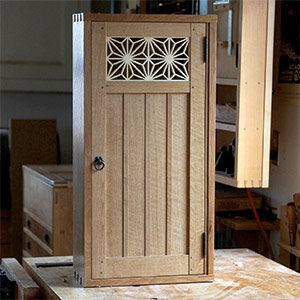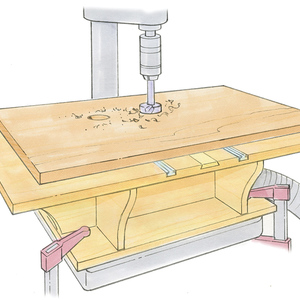
"Fast Fix" is the new home for woodworking quick tips and techniques.
Need a quick solution for a common shop problem? Are you in search of a fast and simple way to perform what might otherwise be a slow and laborious operation? Well, you’ve come to the right place.
Fine Woodworking’s Fast Fix video series is the new home for video quick tips and timesavers that will make life at the bench easier and more enjoyable. Every month, Fine Woodworking editors and contributors will be offering up quick overviews on a variety of nifty shop nuggets that cover everying from easy-to-build woodworking jigs, to little-known shop secrets.
Join Fine Woodworking contributor John White for the maiden episode and learn how to build a super-simple miter saw stand that’s easy on the wallet and great for tight spaces. And don’t forget to check back in the coming weeks for new topics including:
• A smarter stop block
• Unlocking sliding dovetail keys
• Cleaner crosscuts on small stock
Brush up on your shop skills





















Comments
I really liked the "fast forward" format of the miter saw video.
I agree. I think the "fast forward" video is most excellent. It might be a tad too fast but it's a great way to get the gist of how to make it. Would love to see more like this.
Hi folks,
Thanks very much for your comments. You hit on a good point, as just other day I was chatting with someone about possibly slowing the FF just a bit. Thanks for helping to confirm that hunch!
Cheers,
-Ed
I love the Fast Fix. You get all the details without having to sit thru the watching someone drill holes in a board. I hope we will see more of them.
bob
I really hate it when "respectable" sources such as yourself show a table saw being used with guards removed. This is highly irresponsible and totally unnecessary for this project.
Nice miter saw tip for someone with limited shop space. A link to a PDF file containing a summary of the Fast Fix would be nice for someone who collects and organizes such info on my computer.
For the shelf-pin jig, he mentions making sure you drill your holes to match the pin size for your shelves. If you do a lot of shelf construction you could make this jig a bit longer and offset pairs of holes with varying diameters. This way the one jig could accommodate a range of pin sizes simultaneously.
Another "how to" video where the instructor has removed the blade guard on the table saw. This is inherently unsafe and unnecessary for illustrating the cuts to be made. Why do they do this?
Still demonstrating unsafe practices? Would you please put the friggin' guard on that table saw?
To the safety police: why do you need his guards in place? Are you going to use his equipment? I think everyone here knows or should already know that the guards are always removed for clarity as the guards cover much more than a blade. I don't care if another uses the guards - I only care if I do and my children/students do.
jhonbaker - The answer to your question is a simple one. Because some day my children and/or someone I care about (that would include just about everyone) will watch these videos and be persuaded that "this is the way 'real' woodworkers do things".
These videos are intended to teach. When you aspire to teach others, it carries responsibilities - including the safety of the students. FWW wouldn't dream of allowing someone in a video with long unbound hair, loose sleeves, or wearing gloves around rotating machinery. Why do they insist on removing the guards from their table saws for through cuts?
Do it right guys...
I have to agree with the "safety in videos" crowd. An actually DKERFOOT missed something: at about 50 seconds into the stop-block video, you will see Mr. White making a rip cut with his left sleeve unbuttoned. (In most of the other "takes", both sleeves _are_ buttoned.) The cuff probably comes within an inch of the blade. It gave me the creeps to watch that, even before I came down and looked at the comments. I guess my safety neurons were firing!
"Do as I say, not as I do" does not translate well into video.
That aside, I like the design of the stop block, because the hinge reduces the side-to-side slop in the hinged portion. I am always amazed when I see a commercial product, like the stops from Rocker or Kreg. I can always generate 1/16" or more of slop by wiggling their hinged component from side to side.
I'm happy to see that someone else noticed the close call with the loose sleeve in John White's video.
My previous comments were from before the hinged stop-block video was released. I do agree about the loose sleeves.
This video (hinged stop-block) was interesting because the sacrificial fence used provides a legitimate reason for removing the blade guard (though it could easily be modified to allow a guard to be used). But of course, several of the other cuts had zero reason for being done without a guard.
Why do you want to encourage unsafe woodworking practices John White?
I've been a subscriber for years and like your dedication to safety. However, the presenter of the quick fix for a hinged stop block has on long sleeves and the left sleeve is even unbuttoned. So much for table saw safety.
Shorten the music intro. If you watch one after another it gets tedious.
this may be too fast, but here goes...
I seem to forget to apply or release the tension on my bandsaw, I came up with a way to help... I tied a knot in the plug end of the cord... when I unplug it I hang it on the tension lever releasing the tension, when it is time to use the saw I take the plug from the lever, applying the tension and plug it in.
Very helpful and informative but please silence the - frankly annoying & distracting - music whenever giving oral information.
Log in or create an account to post a comment.
Sign up Log in